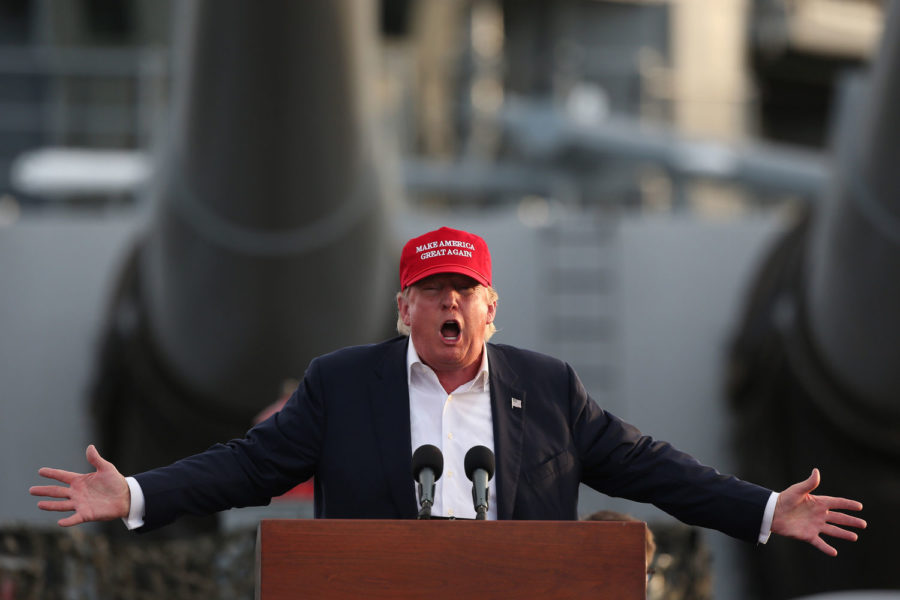Trump’s Twitter war on the ‘crooked media’
President-elect Donald Trump speaks to supporters aboard the USS Iowa battleship in Los Angeles on Sept. 15. (Robert Gauthier/Los Angeles Times/TNS)
August 20, 2016
NEW YORK — Donald Trump outlasted more than a dozen competitors to win the Republican presidential nomination and face off against Democrat Hillary Clinton — except, as it turns out, he doesn’t even see her as his most significant opponent.
“I’m not running against Crooked Hillary,” Trump said at a Fairfield, Conn., rally last Saturday. “I’m running against the crooked media. That’s what I’m running against.”
A Bloomberg Politics analysis of Trump’s Twitter messages during his campaign shows how true that is.
Advertisement
Searching Trump’s roughly 5,000 tweets and retweets since his June 2015 launch for mentions of 25 major media organizations (listed below), Bloomberg Politics found nearly 1,000 examples through Friday morning.
Of those, 256 messages were critical, and together they garnered more than 875,000 retweets and 2.4 million likes.
Over the same period, Trump sent just 140 tweets attacking Clinton. Those got more than 1.2 million retweets and more than 3.3 million likes.
A party’s leading presidential candidate isn’t really expected to focus on his or her general-election opponent until after the primary is over, and Trump didn’t clinch his nomination until May.
But his focus on the media is still unmistakable, and it’s a building block for his dubious argument that the election may be rigged against him. (It’s also likely to intensify, if Trump’s hiring of the antagonistic Breitbart News chairman Stephen Bannon is any indication.)
The five primary targets of Trump’s ire since he announced his candidacy are, in his own words:
The “failing” and “dishonest” New York Times, with 53 attacks (including 37 since January)
Advertisement*
“Ratings-challenged” and “biased” CNN, with 52 attacks (including 14 so far in August)
“Unfair” Fox News, with 46 attacks (most of which were back in 2015)
The “wrong” Wall Street Journal, with 23 attacks, “No credibility” and “dishonest” Politico, with 17 attacks.
Trump’s anti-media Twitter campaigns can be sorted into several categories.
Many were counterattacks against specific coverage, such as a May 14 New York Times front-page story headlined “Crossing the Line: Trump’s Private Conduct With Women,” after which Trump sent out no fewer than 16 tweets.
Some were vehicles to attack longtime enemies, such as New York Daily News owner Mort Zuckerman, whom Trump repeatedly described as “dopey” and “little.”
Others were gripes about the media’s perceived bias, including several tweets that labeled CNN as the “Clinton News Network.”
Others were attempts to undermine unfavorable polls, which Trump dubbed “phony.” He leveled that charge several times against polling partners NBC News and The Wall Street Journal.
In the case of Fox News, many of Trump’s attacks have been directed at specific journalists (e.g., Megyn Kelly) or not-so-subtle suggestions that the network drop certain unfriendly pundits (Karl Rove).
Since March, however, Trump has largely changed his tune on Fox News, whose recently departed CEO, Roger Ailes, Trump calls a longtime friend. Trump has attacked or criticized the network only two times on Twitter while praising it six times.
Trump has praised and criticized Bloomberg Politics journalists, the Bloomberg Politics/Des Moines Register Iowa Poll, and Michael Bloomberg, the founder and majority owner of Bloomberg News parent company Bloomberg LP, who has endorsed Clinton. (In keeping with the overall methodology, only attacks mentioning Bloomberg’s corporate Twitter handles or referring to the media arm were included in the analysis.)
While Trump has kept up a steady stream of attacks against the media since entering the race, he has actually sent out a lot fewer tweets mentioning major outlets overall.
In particular, the number of times he’s cited media polls or upcoming TV appearances has fallen from around 50 tweets in October and December to five in July and just two so far in August (in which he promoted Wednesday’s Fox News town hall-style event with him).
Twitter feuds aren’t Trump’s only response to the media, and there’s likely more where that came from.
One factor working to his advantage: In an era of distrust of many American institutions, the media are no exception.
As Thomas Patterson, a professor at Harvard’s Kennedy School of Government, recently told ABC News, “It’s one of those things where truth is in the eye of the beholder, and trust in the media has dropped so far that a lot of people don’t trust the messenger.”
The full list of media organizations in the analysis includes:
National newspapers: The Wall Street Journal, USA Today, New York Times, Los Angeles Times, Washington Post.
New York City dailies: New York Daily News, New York Post.
Broadcast TV news networks: NBC News, ABC News, CBS News, Univision.
Cable TV news networks: Fox News, CNN, MSNBC.
Newswires: The Associated Press, Reuters, Bloomberg.
Political news or aggregation sites: Politico, Huffington Post, Breitbart News, BuzzFeed News, Drudge Report.
Magazines: Time, National Review, Forbes.
___
(c) 2016 Bloomberg News
Visit Bloomberg News at www.bloomberg.com
Distributed by Tribune Content Agency, LLC.
Advertisement










